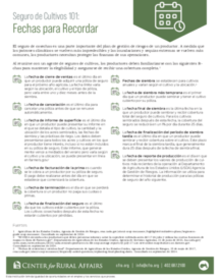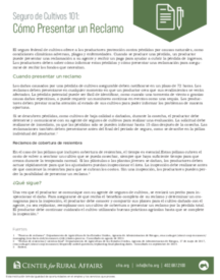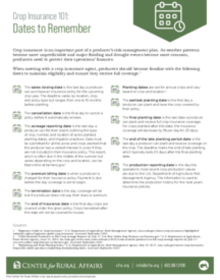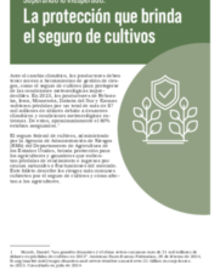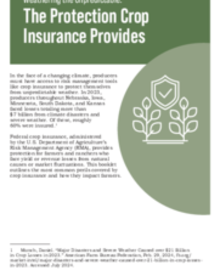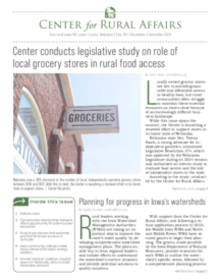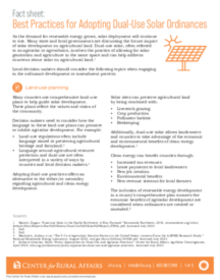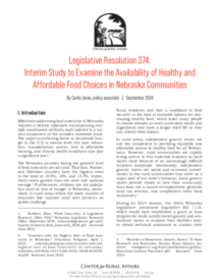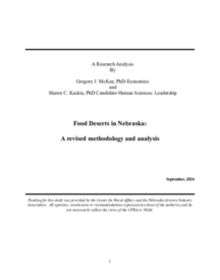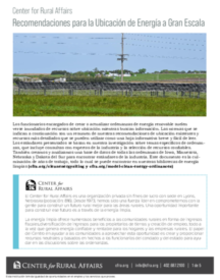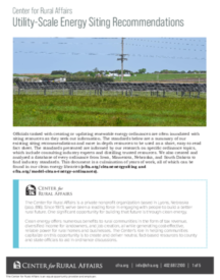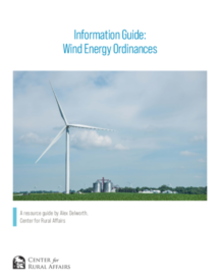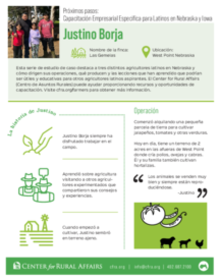We aren't afraid of the weeds. The people living in rural America deserve a serious and in-depth look at the issues and forces impacting their communities.
El seguro de cosechas es una parte importante del plan de gestión de riesgos de un productor. A medida que los patrones climáticos se vuelven más impredecibles y las inundaciones y sequías extremas se vuelven más comunes, los productores necesitan proteger las finanzas de sus operaciones.
- Farm and Food
- Policy
El seguro federal de cultivos ofrece a los productores protección contra pérdidas por causas naturales, como condiciones climáticas adversas, plagas y enfermedades. Cuando se produce una pérdida, un productor puede presentar una reclamación a su agente y recibir un pago para ayudar a cubrir la pérdida de ingresos. Los productores deben saber cómo informar estas pérdidas y cómo presentar una reclamación para asegurarse de recibir los fondos que necesitan.
- Farm and Food
- Policy
A medida que las condiciones meteorológicas severas e impredecibles se vuelven más comunes, la capacidad de los productores para proteger sus operaciones de los riesgos es esencial. La mayoría de los productores están familiarizados con las pólizas de seguro de cultivos que ofrecen protección financiera para cultivos dañados o destruidos, pero es posible que sean menos conscientes de la opción de proteger sus operaciones de la pérdida de cultivos que no pudieron sembrarse: la cobertura por prevención de siembra.
- Farm and Food
- Policy
Crop insurance is an important part of a producer’s risk management plan. As weather patterns become more unpredictable and major flooding and drought events become more common, producers need to protect their operations’ finances.
- Farm and Food
- Policy
Federal crop insurance offers producers protection against losses from natural causes, such as severe weather, pests, and disease. When a loss occurs, a producer can file a claim with their agent and receive a payment to help cover the lost income. Producers should know how to report these losses and how to make a claim to ensure they receive the funds they need.
- Farm and Food
- Policy
As severe and unpredictable weather becomes more common, producers’ ability to protect their operations from risk is essential. Most producers are familiar with crop insurance policies that offer financial protection for damaged or destroyed crops, but they may be less aware of the option to protect their operations from the loss of crops that could not be planted: prevented plant coverage.
- Farm and Food
- Policy
Ante el cambio climático, los productores deben tener acceso a herramientas de gestión de riesgos, como el seguro de cultivos para protegerse de las condiciones meteorológicas impredecibles. En 2023, los productores de Nebraska, Iowa, Minnesota, Dakota del Sur y Kansas sufrieron pérdidas por un total de más de $7 mil millones de dólares debido a desastres climáticos y condiciones meteorológicas extremas. De estos, aproximadamente el 60% estaban asegurados.
- Farm and Food
- Policy
In the face of a changing climate, producers must have access to risk management tools like crop insurance to protect themselves from unpredictable weather. In 2023, producers throughout Nebraska, Iowa, Minnesota, South Dakota, and Kansas faced losses totaling more than $7 billion from climate disasters and severe weather. Of these, roughly 60% were insured. Federal crop insurance, administered by the U.S. Department of Agriculture’s Risk Management Agency (RMA), provides protection for farmers and ranchers who face yield or revenue losses from natural causes or market fluctuations. This booklet outlines the most common perils covered by crop insurance and how they impact farmers.
- Farm and Food
- Policy
Consulte la última edición de Small Business News, repleta de recursos para emprendedores, quienes buscan ser dueños de su propio negocio y gerentes de pequeñas empresas.
- Lending
- Small Towns
Check out the latest edition of our Small Business News packed full of resources for entrepreneurs, those looking to own their own business, and small business managers.
- Lending
- Small Towns
In this edition of our Center Newsletter you will find stories about a legislative study on role of local grocery stores in rural food access, planning for progress in Iowa’s watersheds, the story of Sabino and Maria Hernandez who established their food truck business in Schuyler, Nebraska and found success, among other stories.
- Lending
- Small Towns
- Farm and Food
- Policy
As the demand for renewable energy grows, solar deployment will continue to rise. Many state and local governments are discussing the future impact of solar development on agricultural land. Dual-use solar, often referred to as agrisolar or agrivoltaics, involves the practice of allowing for solar generation and agriculture in the same space and can help address concerns about solar on agricultural land. Local decision makers should consider the following topics when engaging in the ordinance development or amendment process.
- Small Towns
- Policy
Para abordar eficazmente la inseguridad alimentaria en Nebraska se necesita un enfoque holístico que abarque múltiples métodos coordinados, cada uno adaptado a un componente diferente de este complejo problema estatal. El factor principal que contribuye al hambre en los hogares de los EE. UU. es el nivel de ingresos, pero también influyen la raza, la educación, el acceso al transporte, la tasa de viviendas asequibles y las enfermedades crónicas también desempeñan un papel importante.
- Small Towns
- Policy
Effectively addressing food insecurity in Nebraska requires a holistic approach encompassing multiple coordinated methods, each tailored to a various component of the complex statewide issue. The major contributing factor to household hunger in the U.S. is income level, but race, education, transportation access, rate of affordable housing, and chronic health conditions also play a significant part.
- Small Towns
- Policy
Food deserts present a significant obstacle to healthy lifestyles and health outcomes for Nebraska residents. They are designated based on whether residents in a geographic region can access affordable, healthy foods. This study assesses the extent of limited access areas in Nebraska to affordable...
- Small Towns
Los funcionarios encargados de crear o actualizar ordenanzas de energía renovable suelen verse inundados de recursos sobre ubicación mientras buscan información.
- Policy
Officials tasked with creating or updating renewable energy ordinances are often inundated with siting resources as they seek out information.
- Policy
Editor's note: As I write this, it’s county fair time in Nebraska. I don’t know about you, but almost everyone goes to the fair around here.
- Small Towns
- Farm and Food
Wind turbines are multiplying across the U.S., with most installed in rural areas. In the past decade, wind power has accounted for 27% of new energy generation. A majority of the penetration has been in the central U.S., with regional grid networks Southwest Power Pool (SPP) and Midcontinent...
- Policy
Esta serie de estudio de caso destaca a tres distintos agricultores latinos en Nebraska y cómo dirigen sus operaciones, qué producen y las lecciones que han aprendido que podrían ser útiles y educativas para otros agricultores latinos aspirantes. El Center for Rural Affairs (Centro de Asuntos Rurales) puede ayudar proporcionando recursos y oportunidades de capacitación.
- Farm and Food


